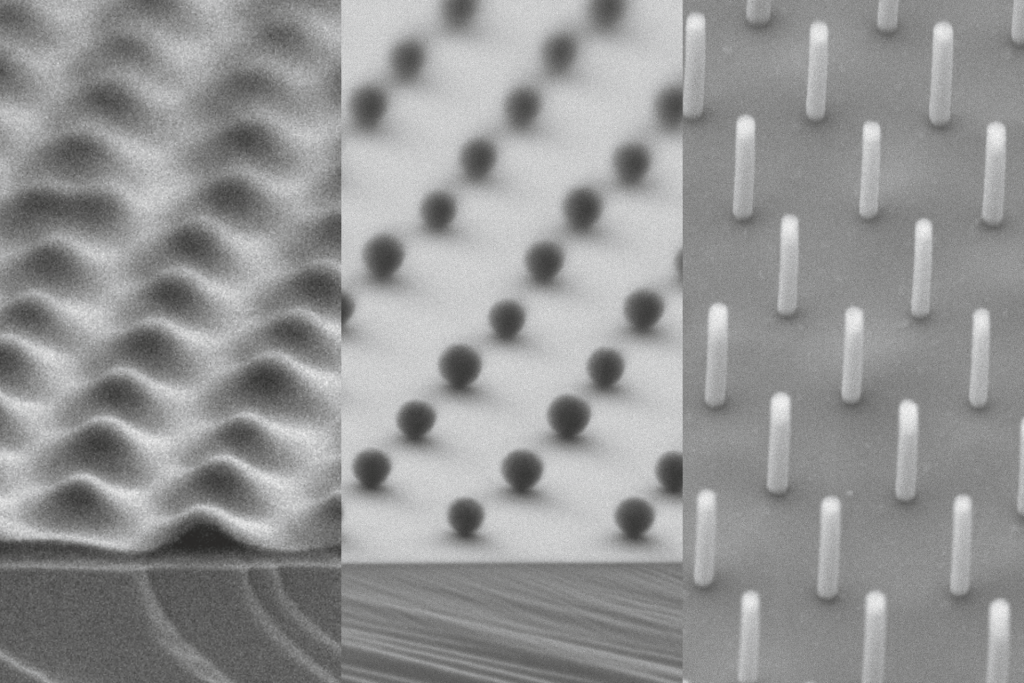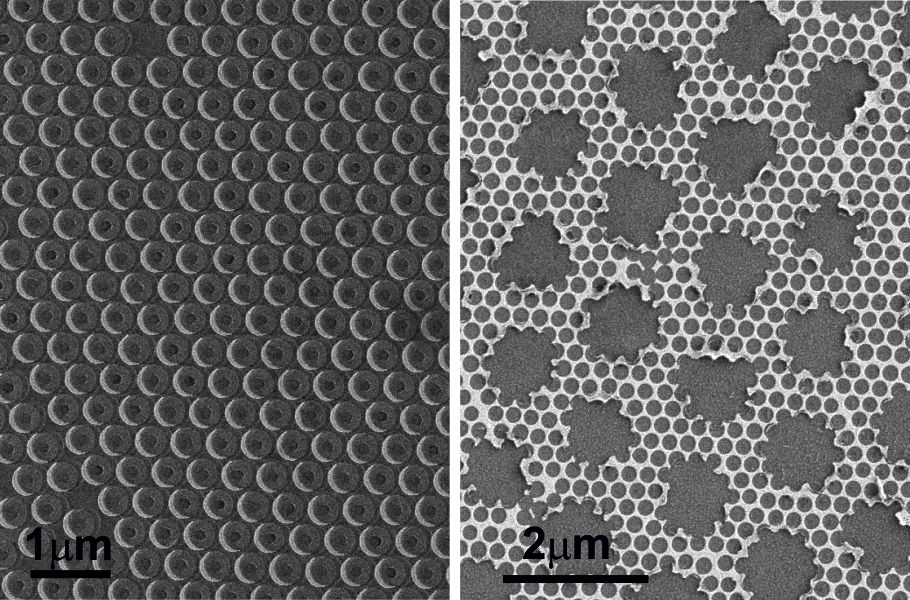Nanostructures and Plasmonics
Creating surface patterns at nanoscale is a key step for different scientific and technological objectives. We apply colloidal monolayers as templates and masks to create optically, mechanically and biologically active substrates. This colloidal lithography approach allows for the preparation of high quality surface pattern over macroscopic dimensions. Our current focus is the design of plasmonic materials with tailored light-matter interactions.
Colloidal Lithography
Colloidal lithography serves as a simple yet efficient tool to obtain wafer-scale nanostructuring. The process takes advantage of the ability of colloidal particles to form ordered monolayer structures at liquid interfaces. We transfer these monolayers to solid substrates, which serve as nanoscale templates to create complex surface structures by a combination of (angular) deposition and etching steps. We develop new fabrication methods to increase the portfolio of available structural motifs and improve assembly and deposition techniques.
Key related publications:
F. Wendisch, M. S. Saller, A. Eadie, A. Reyer, M.o Musso, M. Rey, N. Vogel, O. Diwald, and G. R. Bourret
Three-Dimensional Electrochemical Axial Lithography on Si Micro- and Nanowire Arrays
Nano Lett. 2018, 18 (11), 7343–7349
J. S. Tang, R. Bader, E. S. A. Goerlitzer, J. F. Wendisch, G. R. Bourret, M. Rey and N. Vogel
Surface patterning with SiO2@PNiPAm core-shell particles
ACS Omega 2018, 3, 12089
Plasmonic Nanostructures
In the Vogel lab, we develop colloidal lithography methods to create macroscopic arrays of complex plasmonic nanostructures with tailored optical properties. We currently focus on the hybridisation of resonances within plasmonic molecules, chiroptical plasmonics and lattice related effects such as surface lattice resonances. Our work enables access to large-area high quality substrates with unique optical properties without relying on state-of-art clean room technologies.
Key related publications:
Eric S.A. Goerlitzer, Reza Mohammadi, Sergey Nechayev, Kirsten Volk, Marcel Rey, Peter Banzer, Matthias Karg, Nicolas Vogel
Chiral Surface Lattice Resonances
Advanced Materials, 2020 DOI: 10.1002/adma.202001330
Reza Mohammadi, Maria Ochs, Annette Andrieu-Brunsen, Nicolas Vogel
Effect of Asymmetry on Plasmon Hybridization and Sensing Capacities of Hole-Disk Arrays
J. Phys. Chem. C 2020, 124, 4, 2609-2618
Eric Goerlitzer, Lutz Speichermann, Talha Mirza, Reza Mohammadi, Nicolas Vogel
Addressing the plasmonic hotspot region by site-specific functionalization of nanostructures
Nanoscale Adv., 2020, 2, 394-400
Eric S. A. Goerlitzer, Reza Mohammadi, Sergey Nechayev, Peter Banzer, Nicolas Vogel
Large-Area 3D Plasmonic Crescents with Tunable Chirality
Adv. Optical Mater. 2019, 1801770
F. Wendisch, M. S. Saller, A. Eadie, A. Reyer, M.o Musso, M. Rey, N. Vogel, O. Diwald, and G. R. Bourret
Three-Dimensional Electrochemical Axial Lithography on Si Micro- and Nanowire Arrays
Nano Lett. 2018, 18 (11), 7343–7349
N. Vogel, J. Perez-Juste, L. Liz-Marzan, K. Landfester and C.K. Weiss
Ordered arrays of gold nanostructures from interfacially assembled Au@PNIPAM hybrid nanoparticles
Langmuir 2012, 28, 8985
N. Vogel, U. Ziener, A. Manzke, A. Plettl, P. Ziemann, J. Biskupek, C.K. Weiss and K. Landfester
Platinum nanoparticles from size adjusted functional colloidal particles generated by a seeded emulsion polymerization process
Beilstein Journal of Nanotechnology 2011, 2, 459
N. Vogel*, J. Fischer*, R. Mohammadi, M. Retsch, H.J. Butt, K. Landfester, C.K. Weiss and Max Kreiter,
Plasmon hybridization in stacked double crescents arrays fabricated by colloidal lithography
Nano Letters 2011, 11, 446
Cell-Surface Interactions
New biomaterials for medical implants, tissue engineering and drug delivery are often prepared from polymer/nanoparticle composite materials are applied as particulate coatings and therefore inherently feature a nanostructures surface topography. Especially in the field of bone tissue engineering, where the adhesion of cells with the underlying substrate is crucial for the function of an implant, a detailed understanding about the influence of surface topography is required. We use colloidal self-assembly and molecular surface functionalization to create model surfaces with tailored surface topographies and functionalities to investigate cell-surface interactions and gain fundamental knowledge about the response of mammalian cells to different feature sizes and geometry. We can further include functional properties and external stimuli to manipulate the cellular behavior, for example using light-induced heating of plasmonic structures to transiently create pores in cell walls to deliver active cargos.
Key related publications:
Teresa Walter, Alina Grünewald, Rainer Detsch, Aldo R. Boccaccini, Nicolas Vogel
Cell Interactions with Size-Controlled Colloidal Monolayers: Towards Improved Coatings in Bone Tissue Engineering
Langmuir 2020, 36, 7, 1793-1803
M. Madrid, N. Saklayen, W. Shen, M. Huber, N. Vogel and E. Mazur
Laser-Activated Self-Assembled Thermoplasmonic Nanocavity Substrates for Intracellular Delivery
ACS Appl. Bio Mater. 2018, 1 (6), 1793–1799
S.Egly, C. Froehlich, S. Vogel, A. Gruenewald, J. Wang, R. Detsch, A. R. Boccaccini, and N. Vogell
Bottom-Up Assembly of Silica and Bioactive Glass Supraparticles with Tunable Hierarchical Porosity
Langmuir 2018, 34, 2063
R. Friedlander, N. Vogel and J. Aizenberg
Role of Flagella in Adhesion of Escherichia coli to Abiotic Surfaces
Langmuir 2015, 31, 6137



